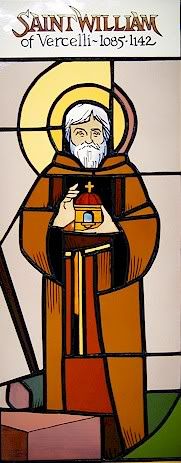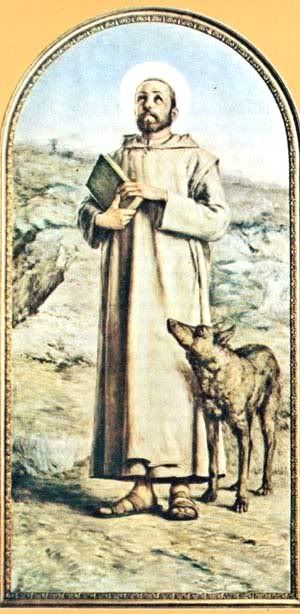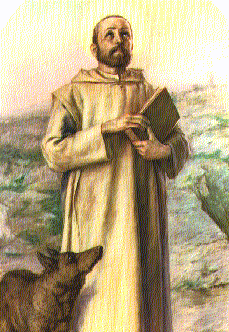Born to nobility in Vercelli, Italy, William was orphaned at a young age when both his parents were killed. Subsequently raised by a pious family member, William matured into a contemplative young man with only one desire—to devote his life to the Lord. At the young age of 15, William left home, setting out on pilgrimage to Santiago de Compostela, Spain. As the journey was not difficult enough for him, he encircled his legs with tight iron bands, causing pain and making walking difficult, his suffering bringing him closer to God. Upon arrival, he worked some miracles including the healing of a blind man through prayer, and subsequently felt called to journey to the Holy Land. However, soon after departing, he was set upon by thieves, and following that encounter, felt the Will of God calling him to Italy.
Saint William retired to Monte Vergiliano (today known as Monte Vergine, named for Our Blessed Mother), and became a hermit. There, he spent his days in prayer, fasting, and contemplation of the Lord. Especially devoted to the Blessed Virgin Mary, he began construction of a church in her honor, mining the rocks from the mountain by hand with the assistance of a lone donkey. As holy legend tells us, one evening, the donkey was killed and eaten by a wolf. Saint William called the wolf to him, ordering it to take the donkey’s place. The wolf, bowing in respect, and realizing that it had interrupted the work of God, immediately took up the task of dragging rocks from the quarry. The faithful who continue to travel on pilgrimage to Monte Vergine report that the wolf is still spotted today, visible to those who call upon the name of the Blessed Virgin.
Eventually, due to his working of more miraculous cures (none of which he sought credit for), the faithful began seeking William out on his mountain. His reputation for holiness attracted many disciples, both men and women, and he founded the Order of Mount Vergine—a religious community with strict rules of austerity. William and the nuns and monks of his order lived in peace and contemplation for some time, until the members of the order began complaining that William’s rules of poverty, fasting, and penance were too extreme.
There is evidence of heavenly support for the austerities of William’s rule. For example, William did not permit the order to eat meat, eggs, milk, or cheese. If someone tried to violate this regulation, storm clouds would appear in the sky and the lightning would destroy the illicit foodstuff that had been brought into the monastery.
 With the members of the Order growing more disgruntled, William humbly removed himself from the situation to remove controversy, and ensure the future of the order. He traveled to Naples, where he served as advisor to the King Roger I, and established several more monasteries.
With the members of the Order growing more disgruntled, William humbly removed himself from the situation to remove controversy, and ensure the future of the order. He traveled to Naples, where he served as advisor to the King Roger I, and established several more monasteries.Saint William died of natural causes at the Guglielmo monastery near Nusco, Italy, where he was buried. Church tradition holds that William predicted the date and time of his death, and went to meet his Maker with peace and joy. At the time of his death, he had not yet written a Rule for his religious to govern their affairs. His successor, fearing the dissolution of a community without constitutions, placed them under the Rule of Saint Benedict. The community, which continues to exist today, now belongs to the Benedictine congregation of Subiaco, and has a much venerated picture of our Lady of Constantinople, to which pilgrimages are frequently made by the faithful. While Benedictine monks generally wear black robes, the monks who reside at Monte Vergine today continue to wear the white robes of the Williamites in honor of this holy man.
Saint William had complete trust in the Lord and in His Divine Providence. Ever faithful and contemplative, William was willing to leave his home as a youth, and subsequently leave the community he had built with his own hands in service to God. Patient, humble, and obedient, Saint William of Vercelli put the Lord’s work above his own desires at every moment of his life. We could do well by observing Saint William’s confidence in the Lord, and striving to imitate him by creating quiet moments in our own lives for prayer, reflection, and contemplation. It is in those moments that the Divine Plan for our own lives quietly unfolds… if we listen.
 O God, Who hast set for us in Thy saints an example and a help to our weakness, to assist us to tread the path of salvation, grant us so to venerate the virtues of the blessed abbot William, that we may share in his prayers and follow in his footsteps. Through our Lord Jesus Christ, Thy Son, Who liveth and reigneth with Thee in the unity of the Holy Ghost, one God forever and ever. Amen.
O God, Who hast set for us in Thy saints an example and a help to our weakness, to assist us to tread the path of salvation, grant us so to venerate the virtues of the blessed abbot William, that we may share in his prayers and follow in his footsteps. Through our Lord Jesus Christ, Thy Son, Who liveth and reigneth with Thee in the unity of the Holy Ghost, one God forever and ever. Amen.Year 2: Day 176 of 365
Prayer Intentions: Quiet moments of contemplation; Open hearts to the Will of God.
Requested Intentions: For a mother’s mental health and for kindness and forgiveness, for housing problems, for dental health (T); For the soul of a departed friend (X); Restoration of health (D); Successful employment for couple (N); For employment for children (K); For health of friend, for successful relationships for children, for safe pregnancy for daughter (C); For the health of a mother (J); Virtue for daughter (V); Successful acceptance to college for nephew (M); For the health of a cousin (T); Freedom from legal difficulties for husband (S); Husband’s freedom from illness (L); Personal intentions (S); Successful passing of dental board examination (P); Blessings on a family (Z); Successful permanent employment (C); Healing of a son with autism (J).




No comments:
Post a Comment
Thanks for leaving a comment. If you wish to submit a prayer request, however, please do so above, using the "Contact" tab.